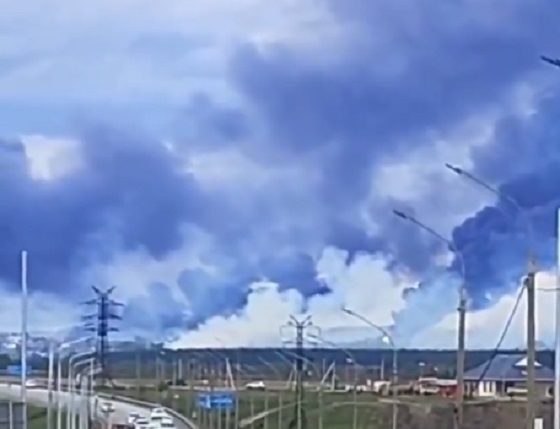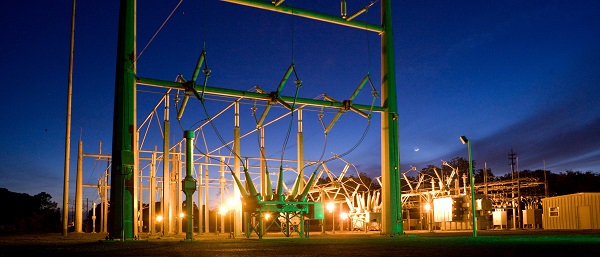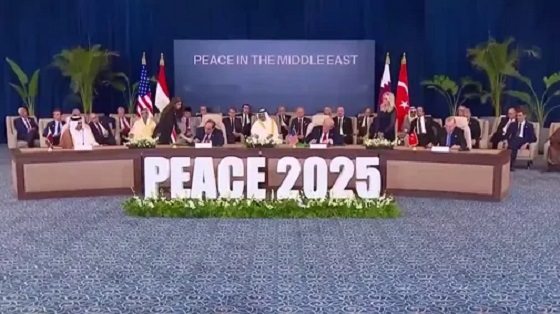conflict
“Will Be in History Books”: Zelensky Hails Long-Range Drone Strike That Hit Dozens of Russian Bombers

 Sam Cooper
Sam Cooper
“Borderline Insane”: Analyst Warns American Military Must Prepare as Ukraine’s Deep Strike Signals China Could Launch Similar Attacks from U.S. Ports in Event of War Over Taiwan

KYIV — In its most daring covert action of the war, Ukraine says it has destroyed or severely damaged more than 40 Russian long-range strategic aircraft in a meticulously planned drone assault that struck four military airbases deep inside Russian territory. The campaign, known as Operation Spider’s Web, marks a stunning escalation in Ukraine’s asymmetric warfare strategy—and what some analysts are calling a historic reversal that could tilt the odds in peace negotiations against the larger aggressor.
The mission—overseen by Ukraine’s Security Service (SBU) and personally authorized by President Volodymyr Zelensky—reportedly took more than 18 months to prepare. SBU operatives smuggled first-person-view drones into Russia hidden inside wooden mobile cabins mounted on civilian cargo trucks. When activated remotely, the trucks’ roofs opened and the drones launched directly at parked Russian bombers.
“This was our most long-range operation,” Zelensky posted Sunday on X, noting the assault involved only Ukrainian forces. “One year, six months, and nine days from the start of planning to execution. These are Ukrainian actions that will undoubtedly be in history books.”
The strikes hit four airbases far from the front lines: Belaya airbase in Irkutsk Oblast, Olenya in Murmansk near the Arctic Circle, Dyagilevo in Ryazan Oblast, and Ivanovo in central Russia.
According to Ukrainian intelligence sources cited by the BBC, the damaged assets include Tu-95 and Tu-22M3 nuclear-capable strategic bombers, as well as an A-50 airborne early warning and control aircraft. The total estimated damage exceeds $2 billion USD.
Footage posted on Russian and Ukrainian Telegram channels showed plumes of smoke rising from the affected airbases. In one widely circulated clip, a bystander can be heard saying drones had launched from “a Kamaz truck near a petrol station.” Russian state media acknowledged strikes across five regions and labeled the attacks “a terrorist act.” However, prominent Russian military bloggers confirmed the loss of aircraft and critical infrastructure, including fuel storage depots.
Irkutsk Governor Igor Kobzev confirmed the Belaya strike, stating the drones had been launched from a civilian truck and that the situation was “under control” with no casualties reported.
SBU officials told the BBC that Spider’s Web was a “logistical and operational breakthrough,” describing a multi-stage smuggling effort that first inserted the FPV drones into Russia, followed later by mobile launch platforms. “Once on Russian territory, the drones were hidden under the roofs of these cabins,” one source said. “At the right moment, the roofs were remotely opened, and the drones took off.”
Zelensky credited SBU chief General Vasyl Maliuk with executing the unprecedented strike. “I thanked General Maliuk for this success of Ukraine,” Zelensky said. “We are doing everything to make Russia feel the need to end this war. Russia started this war. Russia must end it.”
The operation comes amid intensifying cross-border attacks by both sides. Hours earlier, a Russian missile barrage killed 12 Ukrainian soldiers and injured over 60 at a training base. Ukrainian air defenses responded by reportedly downing 385 Russian aerial targets across multiple regions.
The timing of the drone assault—just ahead of a second round of peace talks in Istanbul on Monday—appears aimed at pressuring Moscow. Zelensky has demanded a “complete and unconditional ceasefire,” while Russian officials are calling for a halt to Western arms transfers to Ukraine, a condition Kyiv rejects.
“These strikes are a clear and effective guarantee of Ukraine’s security,” Zelensky said. “Glory to Ukraine.”
Military analyst Tom Shugart noted the implications of the strike could extend far beyond the European theater, warning that Ukraine’s use of covert drone launches deep inside enemy territory raises implications for China’s global trade and access to Western ports.
“A reminder, given today’s Ukrainian drone strikes, that it is becoming borderline-insane that we routinely allow ships owned and operated by DoD-designated Chinese military companies to sit in our ports with thousands of containers onboard and under their control,” Shugart posted Sunday afternoon, referencing mounting U.S. tensions with China over its aggression toward Taiwan.
The Bureau is a reader-supported publication.
To receive new posts and support my work, consider becoming a free or paid subscriber.
Invite your friends and earn rewards
Artificial Intelligence
AI Drone ‘Swarms’ Unleashed On Ukraine Battlefields, Marking New Era Of Warfare


From the Daily Caller News Foundation
Artificial intelligence-powered drones are making their first appearances on the battlefield in the Russia-Ukraine war as warfare creeps closer to full automation.
In bombardments on Russian targets in the past year, Ukrainian drones acting in concert were able to independently determine where to strike without human input.
It’s the first battlefield use of AI “swarm” technology in a real-world environment, a senior Ukrainian official and Swarmer, the company who makes the software, told the Wall Street Journal in a Tuesday report. While drones have increasingly defined modern battlefields, swarms until now had been confined to testing rather than combat.
“You set the target and the drones do the rest,” Swarmer Chief Executive Serhii Kupriienko told the WSJ. “They work together, they adapt.”
So far, the Swarmer technology has been used hundreds of times to target Russia assets, but was first used a year ago to lay mines on the front, the Ukrainian official told the WSJ. The software has been tested with up to 25 drones at once, but is usually utilized with only three.
Kupriienko told the WSJ that he was preparing to test up to 100 drones at once with the linking software.
A common arrangement used on the battlefield includes one reconnaissance drone to scout out the target and two explosive drones delivering the payload on target, the official told the WSJ.
While Western nations such as the U.S., France and the United Kingdom are also pursuing drone swarm technology, they have not deployed swarm technology on the battlefield the way Ukraine has, according to the WSJ. Currently, autonomous weapons are not regulated by any international authority or binding agreement, but ethical concerns around the technology has led many to call for increased regulation of weapons like the Swarmer system.
The Ukrainian Ministry of Foreign Affairs did not immediately respond to the Daily Caller News Foundation’s request for comment.
conflict
Trump Pentagon Reportedly Blocking Ukraine From Firing Western Missiles Deep Into Russia


From the Daily Caller News Foundation
The Department of Defense has spent months blocking the Ukrainian military from using American and British-made missiles to hit targets deep inside Russia, The Wall Street Journal reported Sunday, citing unnamed U.S. officials.
Undersecretary of Defense for Policy Eldridge Colby reportedly designed the procedure to review requests to carry out the long-range strikes with weapons that are either of U.S. origin or that require American intelligence or use components provided by the U.S., according to the WSJ. Secretary of Defense Pete Hegseth reportedly has the final say on whether Ukrainian forces can use the MGM-140 ATACMS (Army Tactical Missile System) to hit targets in Russia.
The reported blocks on missile strikes coincides with a Trump administration effort to broker a peace deal between Russia and Ukraine. A Pentagon spokesperson declined to comment further on the matter.
BREAKING: President Vladimir Putin reacts to B-2 Flyover pic.twitter.com/1mzVn7DxlW
— Jack Poso 🇺🇸 (@JackPosobiec) August 15, 2025
The Biden administration allowed Ukraine to carry out strikes with ATACMS in November, weeks after President Donald Trump won the 2024 election, the New York Times reported. Trump criticized the move during a December interview with Time magazine.
“It’s crazy what’s taking place. It’s crazy,” Trump said. “I disagree very vehemently with sending missiles hundreds of miles into Russia. Why are we doing that? We’re just escalating this war and making it worse. That should not have been allowed to be done.”
Trump and Russian President Vladimir Putin met in Alaska on Aug. 15 for a summit meeting during which Trump sought to secure a cease-fire in Russia’s war with Ukraine. As Trump greeted Putin, a B-2A Spirit stealth bomber and several fighters carried out a flyover of Elmendorf Air Force Base.
Trump met with Ukrainian President Volodymyr Zelensky and major European leaders on Aug. 18 to update them on the summit.
In July, Trump reached an agreement with NATO where members of the alliance would purchase weapons, including MIM-104 Patriot surface-to-air missiles, and donate them to Ukraine.
-

 Alberta2 days ago
Alberta2 days agoFact, fiction, and the pipeline that’s paying Canada’s rent
-

 2025 Federal Election2 days ago
2025 Federal Election2 days agoProtestor Behind ‘Longest Ballot’ Chaos targeting Poilievre pontificates to Commons Committee
-

 Business2 days ago
Business2 days agoFinance Titans May Have Found Trojan Horse For ‘Climate Mandates’
-

 Energy1 day ago
Energy1 day agoIndigenous Communities Support Pipelines, Why No One Talks About That
-

 International2 days ago
International2 days agoSigned and sealed: Peace in the Middle East
-

 Alberta1 day ago
Alberta1 day agoOil Sands are the Costco of world energy – dependable and you know exactly where to find it
-

 Business1 day ago
Business1 day agoFinance Committee Recommendation To Revoke Charitable Status For Religion Short Sighted And Destructive
-

 Alberta1 day ago
Alberta1 day agoThe Technical Pitfalls and Political Perils of “Decarbonized” Oil







